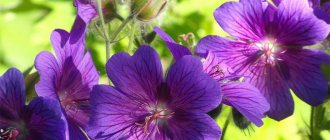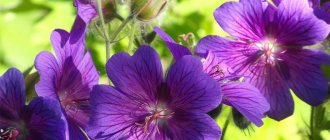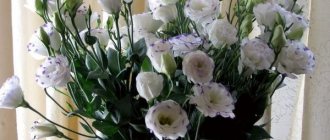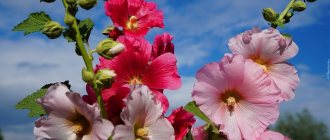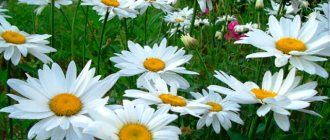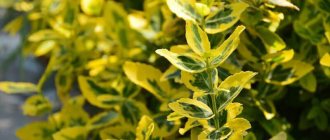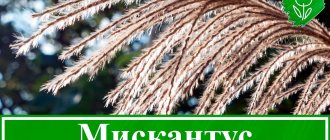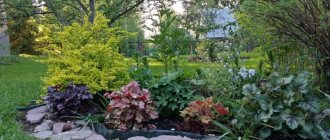- September 25, 2019
- Flowers
- Anastasia Efremenkova
Perennial Eschscholzia is also commonly called California poppy. The plant actually belongs to the Poppy family, which includes approximately ten species that can most often be found in North America. The plant became known as Eschscholzia after the botanist Johann Friedrich von Eschscholz brought it to Russia from California. This plant is very popular among flower growers, which is due not only to its beauty and romance, but also to its unpretentiousness and endurance. In addition, the flower also blooms almost all season long, so why not plant such a miracle in your garden bed. Read more about the features of care and planting of the Eschscholzia flower below.
History of the name
The perennial Eschscholzia received its second name, California poppy, not by chance. Its flowers really look like wild poppy flowers.
There is another legend associated with Eschscholzia, which gives the flower a third name. In the 16th century, gold miners from Spain arrived on the shores of America to find gold mines. Several miles from the coast a golden glow was visible, which they mistook for the shine of gold. But what a disappointment they were when on the California coast they saw only fields of blooming Eschscholzia. Since then, in Spain this plant has been called the golden cup.
Description of the plant
Eschscholzia is a herbaceous perennial that has a taproot system. The plant can reach a height of forty centimeters. Despite the fact that eschscholzia is considered a perennial, it is grown in culture as an annual plant.
California poppy has many thin shoots. The leaves are located on long petioles, have a bluish-green color, and are dissected. The flowers are cup-shaped, solitary, and can reach eight centimeters in diameter. The flowers strongly resemble poppies and can be double or simple. The color palette is varied: red, orange, yellow, white and many shades of these colors. These flowers have a certain peculiarity - in windy and cold weather they do not open, even if it is warm outside, but the sky is overcast, the eschscholzia will not open its flowers. The plant also has a fruit - this is a seed capsule, the diameter of which ranges from three to nine centimeters.
Types of flowers. Popular flowers for bouquets
The group of plants traditionally used by florists includes all types of roses, tulips, chrysanthemums, lilies, peonies, carnations, and irises. But the variety of varieties of the most popular flowers for bouquets often causes difficulties when choosing an arrangement in flower shops. The most questions arise when buying roses.
There are more than 20 thousand varieties of roses in the world, obtained as a result of long-term selection. To compose compositions, varieties that are stable when cut, with a bud that lasts a long time in a half-opened state, are often used. The main value for florists are decorative types of flowers for bouquets:
| Ecuadorian roses are distinguished by a high, powerful stem (up to 100 cm) and a glass size that reaches 7-10 cm. The color scheme is varied: single-color, two-color varieties, varieties in halftones, in which the edges and bases of the petals have different shades. Remains fresh for 2 weeks or more. | |
| Kenyan - have a thinner stem, but have a pronounced aroma. Shrub roses are considered an elite variety. Advantages: variety of shades, varieties, high degree of opening, refined stem, which in combination with a large flower is suitable for single and mixed bouquets. | |
| Russian ones are grown using Dutch technology and have a delicate aroma. Among the most common types of flowers in flower shops are the varieties “Red Naomi”, “Avalanche”, “Aqua”, “Talea”, “Golden Ambition” and others. The first three are considered the most durable when cut, the rest last no more than a week, since they are not preserved with chemicals. | |
| Peony-shaped - a cup-shaped inflorescence in a half-bloomed state resembles a peony flower. The strong aroma, variety of pastel shades, and delicate outlines of the buds allow these flowers to be used for wedding bouquets. The names of the varieties are “White and Pink O'Hara”, “Kahala”, “Voyage”, “Mariateresia”. |
Seed planting of eschsolzia
Many gardeners prefer to plant seeds directly in open ground. But you need to know when to sow Eschscholzia in order to get maximum seedlings. It is possible before winter, around mid-October. Then, during the winter months, the seeds will undergo natural stratification. Thanks to this, spring seedlings will be strong and hardy. You will only need to thin out the beds. Moreover, flowering of such eschscholzia will begin much earlier, which means it will last longer. If you do not have the opportunity to plant seeds in the fall, then you can postpone this procedure to the spring. Until April, the seeds must be stored in the refrigerator, on the bottom shelf. This way you can save planting material and stratify the seeds.
The most beautiful varieties of decorative poppy
The retail chain sells a huge number of decorative varieties belonging to the Oriental poppy species (Papaver orientale), which are used in garden design. The most beautiful are the following varieties:
— Garden Glory. The flowers are double, salmon-colored, the peduncle reaches 75 cm in length;
— Beauty of Livermere. The flower stalks, despite their impressive length, which reaches 120 cm, are quite stable. The flowers are large, bright red with black spots;
— Cedric Morris Large flowers with corrugated pale pink petals, the height of the peduncle reaches 80 cm;
— Fornsett Summer. Corrugated, fringed petals are salmon-red in color, there is a large black spot in the middle of the flower, the height of the peduncle is 60 cm;
—Pattys Plum Lush lilac-pink flowers are located on a thin peduncle up to 90 cm high. It is necessary to plant among plants that will serve as support;
— Picotee. Extraordinarily beautiful two-color flowers: white at the base, and red-orange at the edges with a peduncle up to 90 cm;
— Princess Victoria Louise. Double-layered pale pink flowers are located on peduncles up to 80 cm high.
You can find a photo of any variety on the Internet and order the seeds of the plant that you like best there.
Selecting a location
Before you set a day to plant your seeds, you need to decide where you will plant your California poppy. It should be a sunny area with dry, sandy soil. On the day of planting, it is necessary to make grooves in the soil into which the seeds will be planted. It is recommended to pre-mix the planting material with dry sand. The seeds should be sprinkled on top with a thin layer of soil, and then mulched using peat. This will help the soil not to harden, which means it will be easier for seedlings to break through. If you have autumn planting, then dry leaves should be used as mulch, and their layer should be quite thick so that severe frosts do not damage the seeds.
Preparing poppy seeds
Poppy seeds tend to clump together when they are in their unprocessed, natural form.
They can be difficult to work with, so the poppy seeds you buy at the store have almost certainly been processed to make them easier to work with.
The good news is that this little preparation usually does not contain additives such as preservatives or salts, since poppy seeds themselves are very shelf stable, like most spices.
There are two common ways to prepare and eat poppy seeds:
- The small black spots that most people associate poppies with are lightly fried versions. Roasting gives the poppy seeds a nutty flavor, darkens the color and makes them more decorative.
- Roasting also largely eliminated the clumping of the seeds, making them easier to add to batters and batters. It also helps to sprinkle poppy seeds as a garnish on a sauce or salad.
- Poppy seeds can also be ground into flour . Flour is commonly used to add protein and fiber to breads and other foods and to add a rich and unique flavor. It is not often used on its own, but is instead added to other flours for advanced baking.
- Poppy seeds can also be partially defatted before grinding to reduce the oiliness of the flour, as well as reduce calories and extend shelf life.
- Poppy flour is a great way to boost the protein content of bread and pairs well with whole grain and seed breads.
Because poppy seed flour is gluten- and typically vegetarian , it is a versatile addition to kitchens that need to accommodate food sensitivities and allergies.
Growing seedlings
As already mentioned, it is much easier and faster to plant seeds directly in the ground, so as not to waste time on unnecessary germination. However, more experienced gardeners still advise propagating Eschscholzia with seedlings.
Considering the fact that California poppy has a tap root system, it can be accidentally damaged when replanting. To prevent this from happening, grow plant seedlings in peat tablets.
So, the tablets need to be placed in a plastic container and water should be poured into it, now you should wait until the water is absorbed into the tablets. Remaining liquid must be removed. You should place only one seed in each tablet. To make this process easier, use a wet toothpick. The seeds should be sprinkled with a thin layer of soil on top, the plantings should be sprinkled with water using a spray bottle, and then the plastic container should be covered with a thick film or glass to create a greenhouse effect.
In two weeks you will be able to see the first shoots. At this time, you can safely remove the glass, and move the container in which the tablets are located to a well-lit room, the air temperature in which should not be higher than 20 degrees.
No special care for sprouts is required. It is enough just to moisten the soil in a timely manner and also apply fertilizers. It is best to use mineral fertilizers for seedlings. The first feeding can be done within two weeks after the sprout appears.
Plan in advance when to plant Eschscholzia in open ground, since hardening off the seedlings needs to begin three weeks beforehand. To do this, they need to be placed in a cool place, for example, on a balcony, for several hours. Thanks to this hardening, seedlings in open ground can withstand frosts down to -5 degrees.
How to care for plants in a rock garden
Once you choose the plants you like, you need to plant them in the ground at the appropriate time of year for the specific variety. It is worth remembering that only very young plants with small but strong and developed roots can be planted in the cracks between the stones.
During the first month after planting, it is necessary to water the rocky flowerbed moderately so that the flowers take root well and take root. And for a harmonious neighborhood, you need to leave gaps between them - most of the plants described are ground cover and grow very quickly.
Your rocky flowerbed can be decorative from spring until frost. To achieve this effect, plant plants with different flowering times. And admire the changing bright colors of flowering along with the change of seasons.
Disembarkation time
As already mentioned, the landing site should be decided in advance. The soil should be dry, sandy, slightly acidic or neutral. If the soil in your area is too acidic, then you need to dig up the area and add 200 grams of dolomite flour for each square meter. It can be replaced with two glasses of ash. Determine planting dates taking into account the climate of the region. It is best to do this in the second half of April or the first half of May, when there is no longer a risk of night frosts.
Growing
Growing perennial eschscholzia in open ground will not cause you much trouble. It is only necessary to regularly loosen the soil and apply fertilizers in a timely manner. If the summer is rainy, then there is no need to water the plant. This is only necessary during dry periods.
As already mentioned, the flowering of eschscholzia is quite long, and this can be facilitated by mineral fertilizers, which must be added to the soil before flowering begins. These fertilizers should include potassium, nitrogen, phosphorus, and ash infusion in a ratio of 1:10. To fertilize California poppy, you should not use organic fertilizers, as this can lead not only to disease, but also to the death of the plant.
Please note that perennial Eschscholzia actively reproduces by self-sowing, however, some gardeners do not like this. If you are one of them, then after the flowers fade, you must immediately remove them along with the seed pod. When the plant has completely faded, you can remove the old shoots; new ones will appear in their place quite quickly, moreover, in a few weeks they will begin to bloom.
Diseases and pests
As you can see, growing these perennial flowers in your garden is not as difficult as it may seem to novice gardeners. However, even these simple rules of agricultural technology must be followed, otherwise there is a risk of developing various diseases or the appearance of pests.
At the beginning of summer, bean aphids are especially dangerous for Eschscholzia. Pests can be destroyed by treating the plants with a special preparation called “Commander”. If the summer is particularly hot and dry, there is a risk of spider mites. But you can also get rid of them by treating the eschscholzia with a solution of the Actellik insecticide.
As noted earlier, there is no need to water Eschscholzia if it rains in the summer, since excessive soil moisture can lead to rotting of the root system and other parts of the plant. If you notice any signs of rot, immediately reduce the amount of watering and immediately remove all rotting parts of the plant. If the rot has affected too large areas, it will be better if you remove the entire bush from the flowerbed. Also dangerous for Eschscholzia is a disease such as powdery mildew. When it occurs, the bushes are treated with sulfur.
Properties of Eschsolzia
Perhaps few people know this, but the American Indians actively used Eschscholzia in medicine. Its ground parts are good for toothache, but pollen is a valuable cosmetic product. This property was also discovered by the Indians. A decoction of Californian poppy flowers helped in the treatment of lice.
Now in France, eschscholzia is grown as a raw material and then used in the pharmaceutical industry. Eschscholzia is also popular in the USA, where it is used in pediatrics as a sedative and analgesic. The advantage of this medicine is that it has virtually no side effects, which cannot be said about other benzodiazepine drugs.
Collecting seeds
If the self-sowing option does not suit you, then you need to collect California poppy seeds yourself. This is not difficult to do. However, some are wondering how to collect eschscholzia seeds. It is necessary to put gauze bags on large wilted flowers. This is necessary so that the seeds do not fall out of the box into the ground. They can be removed immediately after ripening. And full ripening occurs exactly a month after the flower withers. After collecting the seeds, they must be laid out on paper and dried. Seeds are stored in paper bags. After wrapping the planting material, you should store it on the bottom shelf of the refrigerator. If all collection and storage rules were followed correctly, the planting material will retain its viability for three years.
Varieties and types
Considering the climate of our country, you can grow only a few varieties of Eschscholzia in your garden: Californian, soddy and Lobb's Eschscholzia. Let's look at them in more detail:
- Eschsholzia Lobba. Low bushes that can reach only 15 centimeters in height. They have small light yellow flowers up to 2 centimeters in diameter.
- Eschscholzia is turfy. Also low perennial flowers. They have thin, bluish-green dissected leaves, which are covered with a waxy coating on top. The leaves are collected in a rosette, and above it you can see a lush yellow cap, which is formed from cup-shaped flowers. Their diameter can reach 3 centimeters. Flowering of this species begins in June and continues until the end of November.
- Eschscholzia Californian. The one that looks like a poppy. This is a herbaceous plant, which is presented in the form of a low shrub (up to 40 centimeters in height). The stem is strewn with ribbed thin shoots of bluish-green color. You can see bluish leaves on the shoots. The flowers are cup-shaped and do not form inflorescences. They can reach 9 centimeters in diameter. The color palette is varied. Flowering begins in June and stops only when frost occurs. Californian Eschscholzia has several varieties: terry (distinguished by lush flowers of a delicate cream color); apple blossom (also double flowers of quite large size; the variety got its name due to the fact that the color of the flowers is really similar to the flowers of an apple tree.); chiffon (seeds of almost all available varieties are collected here, it looks quite beautiful in the beds); ballerina mix (another variety mixture, however, both terry and simple varieties are collected here, with a variety of colors and sizes); Mikado (this variety is distinguished by the fact that in the middle of the yellow flower there is a large orange spot). Each plant looks very beautiful!
Also in our latitudes you can find the Lemmon Eschscholzia. However, gardeners choose it quite rarely. Externally, it has many similarities with Californian Eschscholzia. Although both the first and second types have admirers.
Flowerbed flowers. Planting low-growing flowers that bloom all summer
If you are going to create a colorful corner on your site that is always pleasing to the eye, you should understand how to properly arrange a flower bed so that they bloom all summer and even part of the fall.
Imitation stream
Principles of arranging flower beds
For a competent approach to arranging and filling a future garden masterpiece, it is important not to miss the following points:
- Before running to the store to buy seeds of low-growing flowers for a flower bed, you should clearly determine the location of its possible location, study what the lighting and shade conditions are, the characteristics of the soil, and its moisture content. This is necessary for the correct selection of plants that will be comfortable in this place.
- Beginners should limit themselves to two or three types of plantings—this is enough to create a beautiful flower bed. For your first flowerbed, it is better to choose unpretentious varieties of flowers that do not require special care.
- It is important to choose species with similar requirements for growing conditions for one flower garden.
- It is advisable to use group plantings of the same type of low-growing plants to avoid indiscriminate mixing of different species.
- It is necessary to take a responsible approach to the selection of color combinations for flowering plants. Excessive brightness and variegation are inappropriate and may indicate poor taste. Combinations of various bright and white colors look organic.
- To make a flower arrangement look spectacular all summer long, you need to choose plants with different flowering periods.
- When arranging flowers, you need to take into account the viewing angle. If the flowerbed is visible from all sides, taller specimens should be placed in the center. If its view is possible from one side, the place for tall specimens should be the background.
- To achieve a decent result, preliminary planning of the flower garden with the help of a landscape designer or on your own is required.
California poppy in winter
Despite the fact that eschscholzia is considered a perennial plant, in our latitudes it is grown as an annual. Some gardeners manage to preserve the plant for two seasons. Before the first frost, it is necessary to dig up the area where the eschscholzia grew to remove plant remains. Whether you like it or not, in the spring new entrances will appear in this place, which are the result of the self-seeding of Eschscholzia. There is no need to remove them, just thin out the beds, leaving the strongest bushes. After this, it is worth feeding and in about a month you will be able to again enjoy the abundant flowering of the California poppy.
Aquilegia
Aquilegia is as beautiful as it is dangerous. The plant is considered poisonous, especially many toxic substances are contained in the seeds. Looking at the delicate, beautiful inflorescences of this culture, it is difficult to suspect it of treachery.
In appearance, aquilegia bears little resemblance to buttercups, although it is a relative of them. The flowers of the plant look like bells. However, there are varieties with other types of inflorescences. Additionally, the flowers are decorated with sepals of a contrasting shade.
The plant blooms in the second year after planting. Hybrid varieties are especially beautiful. The seeds of such plants are marked “F1” on the package. The culture is unpretentious in care. The plant does not get sick and easily tolerates sudden changes in temperature. Only some heat-loving varieties need shelter for the winter.
Let's sum it up
As you can see, eschscholzia is not one of the fancy plants. One of its main advantages is its long flowering period - from early June to mid-October. When planting, it is worth considering that the plant loves bright light and dry, sandy soil with a neutral reaction. The gardener also needs to remember that the flower practically does not need watering, and waterlogging of the soil can lead to rotting of the roots and other parts of the plant. Among insects, spider mites and bean aphids are especially dangerous. It is also worth noting once again that eschscholzia has beneficial medicinal properties, and drugs based on it do not cause any side effects.
Hellebore
Hellebore is valued by gardeners for its ability to bloom at inopportune times. The buds of the plant bloom at the earliest possible times, sometimes breaking through from under the snow. Some varieties of hellebore can bloom later - up to mid-June. Hellebore can grow in both sun and shade. He likes heavy clay fertile soil.
Over time, the bushes grow and require division. The height of the plant varies depending on the variety, but does not exceed 50 cm. During flowering, small flowers are framed by spectacular sepals. Petals can be white, pink, violet, cream, purple. Flower growers need to remember that hellebore is poisonous, like other representatives of the buttercups.
